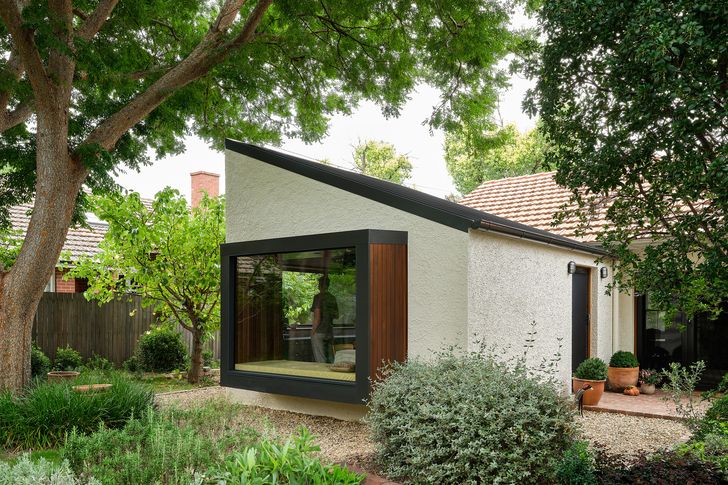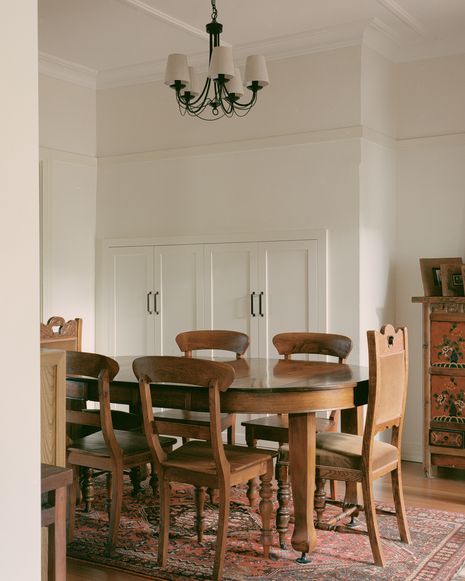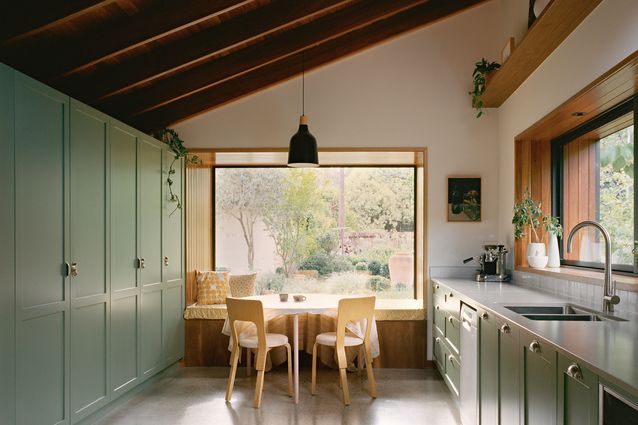When architect Josh Mulford described this project as feeling “particularly Canberran,” his voice was filled with such fondness. What defines Canberra’s domestic landscape, he suggested, isn’t overt architectural expression, but modesty: small, unassuming homes set within native gardens, where the landscape often takes priority over the building itself.
In this project, that idea comes through with clarity and quiet conviction. Instead of the garden fitting in around the structure, the structure defers to the landscape, which now wraps around the addition in all its green and glory.
The brief called for the expansion of a three-bedroom cottage built in 1926 – one of Canberra’s oldest examples of housing – located within the heritage-listed Barton Housing Precinct. Aside from the conversion of a verandah into a sunroom, the house had remained largely untouched since it was built. The clients, a family of four, had long dreamed of improving the functionality of the home, hoping to add a new kitchen, a dedicated dining area and a second bathroom.

View gallery
The home was highly compartmentalised, with little connection between rooms or between indoors and outdoors. “You were always having to improvise,” recalled client Karen Costello, thinking back to the fold-out tables they kept on hand and the need to open doors between rooms to accommodate guests.
Despite its limitations, the original home held strong sentimental value for the clients, who were intent on preserving its character and detailing. They weren’t after a radical reinvention, but a thoughtful addition – one that created space to gather and retreat, without losing the home’s inherent charm. And it all needed to be achieved within a modest budget of $350,000.
After being turned away by several architects who felt the brief couldn’t be delivered within budget, the clients had almost given up hope. Josh Mulford Architects, recommended by a friend, was a breath of fresh air, bringing a more optimistic and resourceful approach to making it work. The result is a compact but considered addition that delivers exactly what the clients hoped for. As Karen put it: “It’s not space for space’s sake.”

View gallery
Measuring just 22 square metres, the new rectangular addition protrudes from the home’s western elevation, containing a new kitchen and informal dining space. Canberra red bricks salvaged from site were reused to create the base of the addition, while the facade uses rough, affordable recycled bricks sourced from nearby suburbs. The brickwork is finished in a rendered roughcast to match the texture of the original facades.
Upon entering the home, a diagonal glimpse of the addition invites closer inspection, but it’s only at the threshold between old and new that the full sense of openness reveals itself. The transition is defined by a change in ceiling height and materiality: spotted gum flooring in the original gives way to the structural concrete slab in the addition, which has been sanded back and matte-sealed to convey a raw, tactile quality. Above, the ceiling lifts to form a pitched slope with exposed timber beams stretching across.

View gallery
The kitchen was designed as an oversized galley. Full-height storage cupboards line the southern wall, allowing a continuous workbench to run the length of the northern side of the room. This arrangement has eliminated the need for overhead cupboards, enabling a large north-facing window to flood the space with light and frame views of the garden. A floating bench seat protrudes from the western boundary of the extension into the landscape, expanding the interior by borrowing airspace from a mature tree and creating the impression that you are being cradled by the tree. Green joinery draws the tones of the landscape into the interior, dissolving the boundary between garden and kitchen, and giving substance to the project’s name.
Very little of the home’s original fabric was demolished; only a few internal walls were removed to better connect the new and old sections. One such space is the former kitchen, now transformed into a dedicated dining area and opened in three directions to facilitate flow between social spaces. Another is the former laundry and pantry, which has been combined into a single bathroom, incorporating a European laundry.

View gallery
Changes to the house may be small in scale, but they’ve had a big effect. The overall experience of the home has been completely transformed. For Karen, this has culminated in joy. “We get so much joy from entertaining, the children being able to have friends over, or just having private spaces to retreat to when needed. We have those options there now.”
The impact of the project is not only felt by the clients. Josh explained that with current affordability challenges and rising construction prices creating a barrier for people to engage architects, he has a genuine ambition to make architecture more accessible by taking on projects like this – work that he finds particularly rewarding. He has created a beautiful home that captures the essence of Canberra’s garden city legacy: a deep respect for nature, where architecture integrates with the surroundings rather than overshadows them.


Comments are closed.